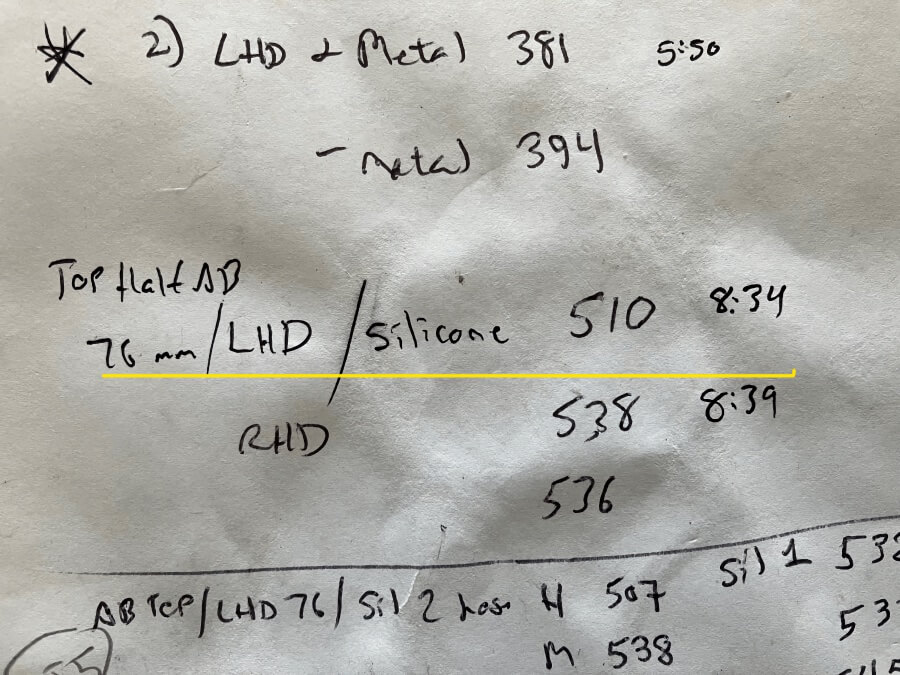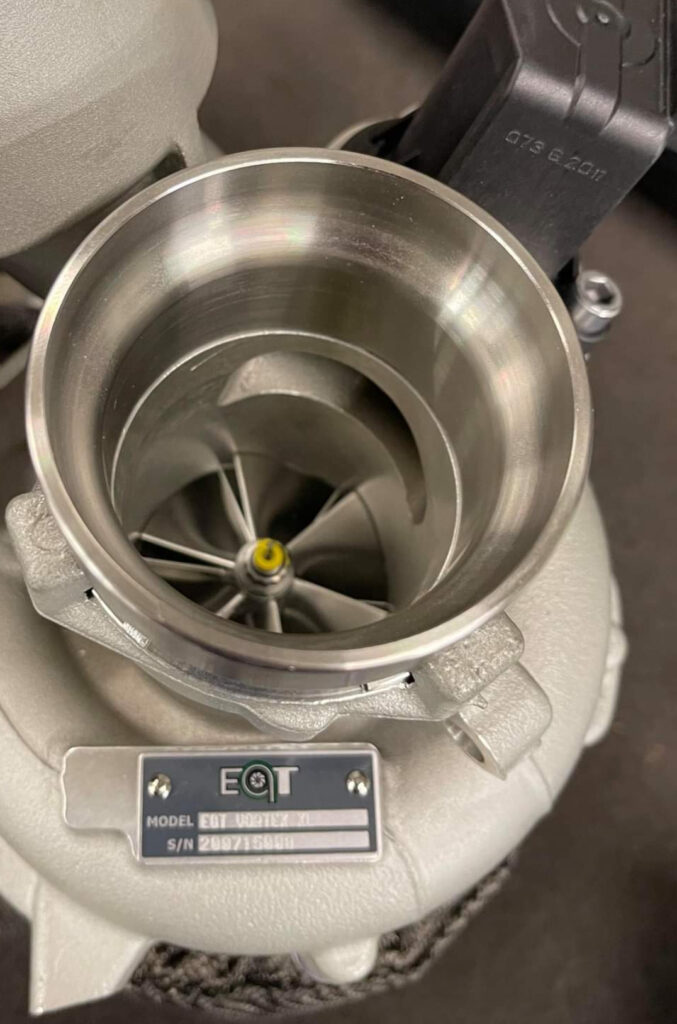Background:
This post continues a review of occasions where I have been presented with “real world” data related to the performance of the Blaze Performance intake.

This second case of “real world” data being presented to me for consideration took place simultaneously with my initial testing of the AToM V1 intake at the beginning of October 2022.
The information was supplied secondhand by somebody considering purchasing the Blaze intake who was interested in learning how the flow tests were going.
The entire dialog is presented at the bottom of this post.
Discussion Overview:
The gist of the discussion was trying to reconcile results that had been communicated to this person from a customer of Equilibrium Tuning, with the flow test results I was gathering.
Early in the discussion, there was misinformation about the size of the Vortex turbo inlet, where it had been communicated to me that it was the same size inlet as the stock IHI turbochargers. This misinformation contributed to difficulties in reconciling the separate results.
The person had told me that EQT had seen the ability to operate a customer’s Vortex standard turbo with an additional 4 psi of boost pressure after swapping out an IE intake for the Blaze intake. This was inconsistent with the results I had obtained using a stock turbo-sized adapter.
After a couple of days, this person and Blaze Performance helped to confirm that the Vortex turbo has an inlet larger than the stock IHI turbos and that the EQT comparison had been done using an Integrated Engineering intake and IE turbo inlet elbow.
At that point I was able to inform the person of the following about the “real world” results:
Information Comparison:
The difference reported by the enthusiast for the EQT parts swap, potentially an additional 4 psi of boost, is consistent with the flow test measurements made using the IE turbo inlet elbow and Blaze Performance turbo flange.
The Integrated Engineering turbo inlet elbow was flow-tested over three years ago and was found to flow 475 CFM @ 28″ of H2O when attached to the flow bench using a silicone coupler that has an inside diameter of 57mm (similar in size to the 56mm inlet diameter of the Vortex turbo).

Shown above are the results of flow testing the Blaze turbo flange with the same silicone coupler.
The Blaze product flowed 510 CFM @ 28″ of H2O.
The Blaze flange supports an additional 7.4% of airflow at this test depression versus the IE TIP.
These measurements correlate with the product dimensions, the Blaze flange has a 56mm inside diameter versus the Integrated Engineering TIP inside diameter of 49mm.
Note: Differences between the 100 mm and 76 mm silicone hoses were found to be minimal. When comparing a Racingline filter with a 76 mm hose and the Blaze R600 filter with a 100 mm hose, through the silicone coupler, the difference in flow rates was 3 CFM (488 vs 491).
Looking at the results reported for the Vortex turbo, it was stated that the boost pressure was able to be increased from 33 to 37 psi.
Assuming the conditions were equivalent in each case and the 2L engine was turning at 6,000 RPM, the volumetric flow rate needed to support this boost pressure would be approximately 732 CFM.
An increase of boost pressure to 37 psi, at the same engine speed, would correspond to an increase in airflow to approximately 790 CFM.
An airflow increase from 732 CFM (33 psi) to 790 CFM (37 psi), is a 7.9% increase in airflow.
Conclusions:
The 7.9% airflow increase from swapping the IE parts to Blaze parts on the EQT turbo-equipped vehicle is similar to the 7.4% increase between the IE TIP and Blaze flange that was measured on the flow bench.
Claims made by enthusiasts and tuners that this “real-world” data has been disregarded are unfounded.
Results comparison discussion with enthusiast:
My replies are the italicized text.
10/3/2022
Hey jeff excuse the random message, was just curious if you have gotten to test that blaze intake by any chance? I’m trying to decide if I want to spend $550 for it and if it’s even worth it over my 3.5 cts intake, price is a little high if there is not a significant increase in performance or flow just curious.
I’m in the process of testing some of the parts now.
Oh right on! Just curious man I’m talking to Mason I and he was able to push more boost because of that intake. So I’m really leaning towards it
What turbocharger are you using?
Vortex XL
Do you know if the throat to the compressor wheel is larger than the IHI turbos? That is where I think the Blaze products are likely to be more beneficial. I can’t say yet if it is much better than the CTS intake measured as I do.
Yes definitely lager

He was able to push his vortex standard from 33 to 37psi here in Colorado just by switching to that intake
The adapter is larger, but is the inlet of the compressor housing? That compressor inlet looks like it is the same size as the IHI turbos. I’m skeptical that an intake led to a 4 psi increase if the previous intake was decent.
Here is a photo of his ap with an unfinished tune he is peaking 37psi now completely pushing it
10/4/22
There are a number of factors that contribute to how efficiently the turbocharger produces boost pressure. Is the inlet of the XL compressor housing a larger inside diameter than the IHI turbos? I haven’t tested the current version of the IE intake. Was the setup using the IE inlet elbow with the IE intake?
I believe the housing inlet is the same size is more inside that has been machined to fit larger wheels, and yes complete IE intake his car was running 33psi 100% WG duty cycle. Swapped over intakes and WG dropped 7% allowing an extra 4psi
This is what I’ve been told by him and the team at eqt
Note: Blaze confirmed that the information given to me about the housing inlet above was incorrect. The Vortex compressor inlet is larger than the IHI turbos. Blaze sent me this photo of a Vortex with their flange attached.

I found an pic of an eqt vortex compressor housing, with the version one of my adaptor. Good illustration that shows that the ID of the turbo and the flange are both 56mm which makes a case for the need of another group of tests for intakes that can maximize this feature.
I have also confirmed that the car with the IE intake test comparison has the eqt vortex standard with the same compressor housing inlet diameter.
Blaze Performance
Absolutely pushing the turbo no doubt but that was at his request, only thing that was changed was Intake and turbo inlet for the blaze kit and a retune
Something else probably changed, likely with the environment, that they weren’t aware of. The compressor housing is the most significant factor limiting how much airflow can pass through the intake. All of the best flowing intakes I have tested, including Blaze, top out around the same point. The differences between the best intakes are minimal. Either this IE intake was below avg., or something else changed. The likelihood the Blaze intake made the difference is low.
Would outside temp maybe? I mean it hasn’t changed more than 15-20 degrees compared to summer when it used to be 98-100 or what other factors you think ? I’m just surprised he has been able to push that much through that setup, Dave @eqt told me I was pushing my xl at 31psi haha and this guy is completely ripping his standard apart just trying yo figure this out too. Like I said nothing else has changed with his car besides Intake and tune, he logged it before the intake and right after with in the same day and same tune and like I said it allowed that much more airflow
It blew my mind away haha considering that here in Colorado is so hard to tune hybrids because of air density, that’s why I reached out to you to see if you had some info on it because I’m still having a hard time believing that an intake can improve that much, and well I don’t want to waste $550 on something that might not work for me.
I don’t think there are any surprises coming from any new intakes. A “new” product that is far better than what has come before it? Not likely at this point. If unbelievable results are being reported, they probably should not be believed. These results are also out of line with what I have measured, assuming the IE v2 is at least as good as the IE v1.
Yea that’s true, not sure man to be completely honest with you. I know there is alot of hype on this intake to the point where eqt is trying to partner up with them to be a dealer because they have seen such great results, again I followed all your testing to make my cts intake the best flowing intake possible but with all the hype this is getting it really made me consider it but not sure if I’ll be as much as an upgrade for me since my intake is already a 3.5 compared to a 4” because at the end of the day the bottom neck of that intake is a 4” yes it can have a huge 6” scoop but it reduces down so not sure. Might have to wait to see what results you get before pulling the trigger
Do you know if that car is using the full-width duct or the single-side duct?

That’s the car
That’s the full-width duct. I have the single side. I think Blaze is sending that duct separately.
I was told It’s part of the new 6” air duct

Is this what you have?
Yes, it’s only open on one side.
Oh yea that’s the old style, that one Mason is running is a new design not even on their website yet you need to contact them directly to get it You have the 4” all the way to the turbo I believe that new one uses the duct all across the front and has a 6” scoop with filter and it goes down to 4” at the turbo
The only difference is that the parts I have don’t include the full-width duct. That’s still en route to me.
The AToM intake is 6″ at the opening and decreases to a 100mm/4″ hose. At the turbo inlet it steps down again to 3″/76mm. They also sell a 3″/76mm hose for use with the stock airbox, or other similar size intakes.
Oh okay I see I wouldn’t think a full-width duct would be what makes the difference.
Have you been able to test the flow through it? Wonder why some people swear by it now and it looks like a lot of orders are being placed, I need more data to justify the price!
I’ve been working through it. They sent a bunch of components that can be configured in different ways, and I have both right hand drive and left hand drive parts, so it’s taken a while.
In the next day or two I should have the turbo inlet hose write up completed.
Can’t wait man!
10/5/22
Great post as always!! So definitely a decent flowing intake
Not sure it’ll be worth it over my cts with mst Inlet than, maybe just a little you think?
That test is just of the inlet hose. For people with an IHI turbo it’s a good performing product, but so are a number of other options. So far I have seen no indication that it is far superior to other intakes when used with the IHI sized turbo housing.
Makes since and yea basically all hybrids have the same style and size housings it only changes when going to the full frame
Is the picture above of the turbocharger yours or the car that EQT was tuning?
I believe it’s a picture from blaze but don’t take my world for it, it was shown to me to show me the size of the turbo inlet
No it seems like an oem turbo to me but not sure

So what really makes the difference is that piece?
Yes.
Interesting! Well in that case keep my intake and swapping over to that tip or similar some how would give me some difference if any
That’s 56mm ID or OD?
So is that piece 56mm flange to 100mm on the other end where the hose connects too?
Basically same thing as the Revo kit than?
It’s very similar to the Revo. The Blaze inlet hose is 100mm at the inlet. It tapers to 76mm/3″. All of the Blaze inlet hoses use the same adapter.
Blaze offers a 76mm and 100mm hose.
Which one did you test?
This test is of the 3”.
Ooh okay I’m guessing you haven’t gotten your hands around the 4” setup yet?
I have all of the intake parts that they sell. I’ll get around to reporting the other results after I get the data analyzed.
I’m curious what you get on that one
10/10/22
Posted the results of ATOM V1 testing.
Sweet! Looks like that inlet flange is what makes the difference again?
As with most intakes I’ve tested, what Turbo Inlet Elbow/Adapter is used is critical to how well it flows. The Blaze adapter is a good part.
I see, well crap I guess it’s time to find one to get my hands around it
I think the adapter they’ve got is really well designed. The other parts have some room to improve upon. This is the first time they have had their parts tested outside of a vehicle. It’s much easier to discover that a part like the LHD inlet hose is sub-optimal when you can swap just that part with the RHD model and see airflow increase.
Will the rhd fir the LHD?
I don’t think so. I haven’t tried fitting it though.
Oh okay, might contemplate buying one today, price is definitely something that’s holding me back but we’ll see

You almost can’t make this stuff up. Variable control and testing consistency seems to be a foreign concept to many in this community.